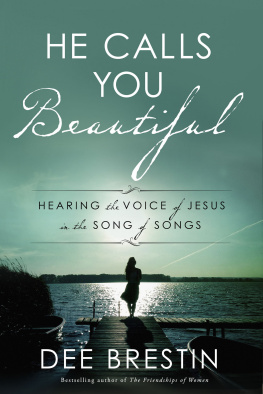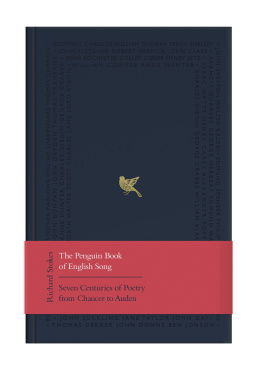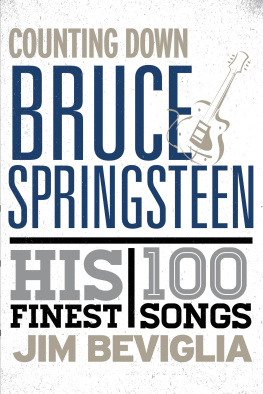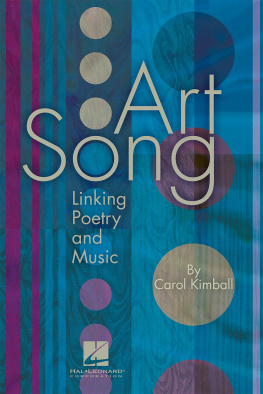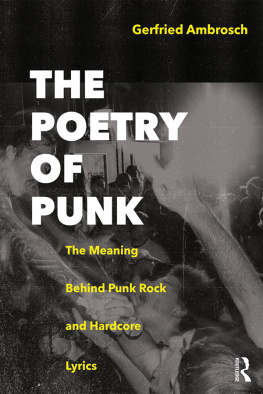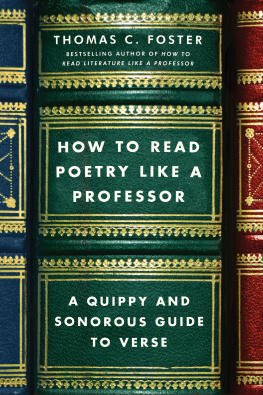Lines and Lyrics
Lines and Lyrics
An Introduction to Poetry and Song

Matt BaileyShea
Yale
UNIVERSITY PRESS
New Haven and London
Copyright 2021 by Matt BaileyShea.
All rights reserved.
This book may not be reproduced, in whole or in part, including illustrations, in any form (beyond that copying permitted by Sections 107 and 108 of the U.S. Copyright Law and except by reviewers for the public press), without written permission from the publishers.
Yale University Press books may be purchased in quantity for educational, business, or promotional use. For information, please e-mail (U.K. office).
Set in Merope type by Tseng Information Systems, Inc.,
Durham, North Carolina.
Printed in the United States of America.
Library of Congress Control Number: 2021931596
ISBN 978-0-300-24567-7 (hardcover : alk. paper)
A catalogue record for this book is available from the British Library.
This paper meets the requirements of ANSI / NISO Z 39.48-1992
(Permanence of Paper).
10 9 8 7 6 5 4 3 2 1
For Chelsea, Kilian, and Rory
CONTENTS
Note to the Reader
This is a book that encourages close, attentive listening to songs. It will be difficult to follow the ensuing discussion without having a direct connection to the music. To help make everything as accessible as possible, I have created a Spotify playlist called Lines and Lyrics (available at https://open.spotify.com/playlist/2Idu5dQlDgFe94qm2WUIG6). Throughout the book, Ill refer to this playlist. When I want to direct your attention to a specific moment in the middle of a song, I will reference a specific timestamp (e.g., Spotify playlist, track 42, 2:17).
All the songs under discussion can be accessed by alternate online platforms, such as YouTube, but the times might not be exactly synced with the Spotify playlist. This should not cause much confusion, however. Listening to any versions of the songs while following along with the book will make the reading experience more valuable and more rewarding.
Lines and Lyrics
INTRODUCTION
Why Study Lyrics?
We were born before the wind
Also younger than the sun
Ere the bonnie boat was won
As we sailed into the mystic.
Many readers will recognize these lines as the opening of Van Morrisons Into the Mystic from the 1970 album Moondance. The song is widely viewed as a classic; it still gets played regularly on rock radio stations around the globe. It is not, however, great poetry. Imagine if Morrison, rather than writing a song, had tried to publish these lyrics as a poem. He probably would have suffered many rejections. Poetry editors no doubt would have cringed at the faux mysticism, the clichd sentimentality, and the borderline meaninglessness of its verses. These words come to us not as a written poem, however, but as a song. And the words, shaped into melody, are beautiful (Spotify playlist, track 1).
In a 1978 Rolling Stone interview, Morrison adopted a familiar anti-intellectual, rock & roll posture when asked about his lyrics, arguing that people take them too seriously and that the words might even be irrelevant. Anyone interested in studying his songs, then, might follow suit and simply set aside the lyrics and focus on other things: the harmonies, the texture, the rhythm and meter, the vocal timbre. Why bother engaging in serious interpretation of the lyrics if they are no more than a vehicle for a catchy tune?
We should be careful, however, not to adopt such a dismissive attitude. What happens, for instance, if we do take a closer look at the lyrics? There is actually quite a bit to savor. The opening line is heavy on alliteration: The ws at the edges of the linewe, were, and windflank the bs in the middle (born before). There is nothing especially ingenious about this (alliteration comes easily), but it chimes nicely with the third line, which retains those internal bsbonnie boatand brings back the ws as well (was won). There
But notice also some of the striking differences. The word mystic, for example, is unlike any other sound in the lyrics thus far. It has no rhyming or alliterative partner. And its two syllables stand out in contrast to the other concluding, single-syllable words: wind, sun, won, mystic. That final word punctuates a line that is different from the others in size and accent. It has eight syllables, and although we could force it into the same four-stress pattern as the previous linesas we sailed into the mystica more natural reading would be much lighter and quicker, with only two strong accents: as we sailed into the mystic. The contrast is significant: it provides a change of pace that aligns well with the conclusive turn of phrase in Morrisons melody, which relaxes, for the first time, into a stable tonic as the final note (the tonic is the resting point at the beginning and end of a musical scale).
Perhaps more vital, however, is the way this serene, quasi-mystical language contrasts with the songs first climactic outburst: I want to rock your gypsy soul. This line, occurring about one minute and twenty-five seconds into the song, must be heard to be appreciated. It is a perfect microcosm of Van Morrisons vocal talent. Like the opening lines, it is not great poetry, but it is powerfully effective as a lyric. The entire song appears to be addressed to a lover, but the effusiveness of this moment is markedly different from the odd past-tense voice of the opening, which might be imagined as a strange, first-person-plural narrator (we were... we sailed...). This climax is something else entirely: a far more direct, present-tense exclamation with a contemporary phraserock your gypsy soulthat draws on the previous old-world diction but with a more modern spin. It is the first point in the song at which Morrison vaults into a distinctly higher vocal and emotional register, and the contrast with the earlier lyrics reinforces the musical shift.
Simply put, and despite Morrisons protestations to the contrary, the words to this song matter. The sounds of the words matter. The patterns of accent matter. The phrasing, the connotations, the narration and address all contribute to the musical effect of the entire song. I would hope that this would be an obvious point. How could the words of a song not matter? Bob Dylan, after all, won the Nobel Prize for Literature. And yet skepticism about the role of language in song often persists, perhaps even for good reason.
Consider the devils advocate position. To begin with, songwriters themselves, like Morrison, often draw attention to the irrelevance of their lyrics. Indeed, they sometimes do it in the lyrics themselves. Here, for instance, are the opening lines of the song Hook, a 1994 hit by Blues Traveler (Spotify playlist, track 2):
It doesnt matter what I say
As long as I sing with inflection
That makes you feel that Ill convey
Some inner truth or vast reflection.
Many readers, no doubt, will recognize a flash of truth in these lyrics. Who among us has not enjoyed a song, perhaps one we have heard many times, without really processing the lyrics? How many listeners, when hearing the opening verse of Tumbling Dice by the Rolling Stonesthe biggest hit from one of their greatest albums, Exile on Main Street (1972)could comprehend more than a quarter of Mick Jaggers words? The bluesy inflection is clear; the lyrics are not (Spotify playlist, track 3).
Next page

